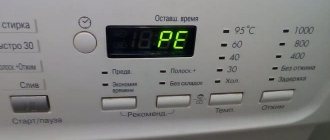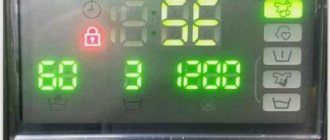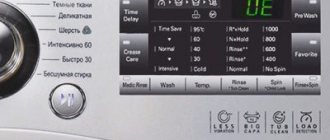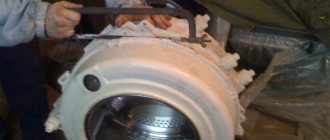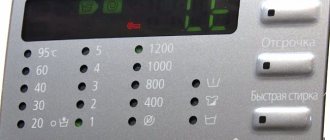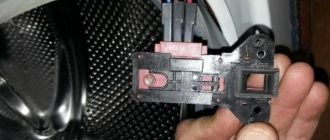How to clean the drain hose in a washing machine. Blockages are the most common problems of the SMA. In case of such a problem, calling a technician or transporting it to a service center is not necessary. It’s quite possible to solve it yourself.
Some people mistakenly believe that you can clear a blockage in a hose by simply rinsing it with running water. In principle, this is true, but first it should be dismantled without damaging it, and then installed back.
- Causes of clogs in washing machines
- Signs
- Cleaning without disassembly
- Dismantling in different models of washing machines
- Flushing
- Preventing blockages
- SMA catalog with reviews
Causes of clogs in washing machines
Clogging of the drain hose occurs due to mechanical and natural reasons. The first signal that the drainage is clogged is difficulty draining liquid from the device during squeezing or draining.
If the machine malfunctions during these steps, it means a blockage has formed. If it is strong, the drainage system is completely blocked.
Drain hose sma
Natural blockage
As a result of operation, the drain hose becomes clogged with fabric fibers, particles of dirt, hair, and pet hairs. All this sticks to the walls of the tube, reducing its lumen. As a result, a hard and viscous substance is formed, which consists of detergent residues, dirt, fibers and wool.
Mechanical blockage
Clothing accessories, coins, small toys, as well as decorative elements of things can get stuck in the drain hose.
Possible problems
When replacing the hose of an LG washing machine, you may encounter problems such as:
- Sometimes there are difficulties in removing the hose from the SMA, since it does not fit through some openings. In this case, the part can simply be cut.
- An old hose may leak water. To prevent it from getting on important parts, you should always keep a rag at hand.
- If the new hose is too short, it can be lengthened. However, the length must be controlled, since non-compliance with standard sizes increases the load on the pump and can cause it to break.
Online diagnostics of a washing machine
If your machine stops washing or rinsing clothes normally, then some kind of malfunction or breakdown has occurred.
You can try to find the problem yourself. Run diagnostics
Select which operation your washing machine does not perform:
1. Doesn’t drain 2. Doesn’t rotate the drum 3. Doesn’t spin clothes 4. Noises, knocks, buzzes when spinning 5. Doesn’t turn on
Checking the operation of the drain pump Is the drain pump of the washing machine working? Yes No I don’t know << Back
Clogged hoses in the washing machine If the sound corresponds to the normal sound that has always been observed when the device is working, the cause is probably a clog.
Was there a blockage in the drain hose? Yes
<< Back
The drain pump does not work! If the sound matches the normal sound of the drain pump, it is recommended that you check the drain filter first.
After cleaning, does the drain pump work and does the washing machine drain water? Not really
<< Back
Operation of the drain pump The sound of the pump is usually immediately audible and noticeable. If there is no sound, the pump is not working. We are looking for how to separately enable the water drainage program. As a rule, this is a separate option. After the program has been turned on, the pump should start working in 1-3 seconds. If everything is done correctly and the pump is operational, a buzzing sound will appear. If you hear no buzzing or other sounds when you turn on the program, the pump is probably faulty.
Is the washing machine drain pump working? Not really
<< Back
Clogged car hoses If you have identified a clog in the hoses, you need to disassemble them, clean them, and then reassemble everything.
Does the washing machine drain well? Not really
<< Back
Hurray, you did a great job, you fixed it.
<< Return to the beginning of diagnostics
The drain pump is faulty, call a professional.
<< Return to the beginning of the diagnosis.
The washing machine does not rotate the drum. During the operation of the washing machine, such a problem may occur. Each model has a different drum operation. It rotates according to a given algorithm, which is set by the program. This principle applies to spinning and washing. If you are not sure whether the drum is not spinning or whether it is working, put the laundry in the washing machine. Start the spin program. If the machine is running, it will first drain the water and then start spinning. In this case, a rotational process will be observed. If rotation is not visible, then check the belt. First, turn off the program, then unplug the wire from the outlet so that power does not flow into the device. Now you need to remove the back cover. You will need to carefully inspect the drum belt. It is quite easy to determine whether it is in the wrong position or damaged.
Is the washing machine belt torn or stretched? Not really
<< Back
Broken drum drive belt If the belt breaks, it will be immediately visible. There are also often cases when the belt simply stretches, which is why the drum, accordingly, does not rotate. Do not allow the machine to operate if the belt breaks. It is important to check whether it has wound around the engine pulley or broken the wiring to the engine. The heating element and temperature sensor may also be damaged if the belt does catch the wires. It is imperative to ensure that the belt model is original. If you choose an unsuitable or low-quality product, this will affect the performance of other devices. How do you know what kind of belt you have? There will be a marking written on the old one, compare it with the one indicated on the belt offered to you. You can also find out belt information by car model.
<< Return to the beginning of the diagnosis.
Washing machine motor malfunction If a malfunction is not found, the block with wires must be disconnected from the electric motor. Carefully remove it. We visually evaluate the engine. It may have melting, cracks, or other effects that clearly indicate damage. We call the windings of the tachogenerator and the engine. It is important to understand that you can fully study how correctly the engine operates and whether there is a malfunction only at the stand. If rotation does not occur, there may be a problem with more than just the motor. Sometimes the cause is a malfunctioning electronic module. If a short circuit occurs in the engine, the module could be damaged, while the engine remains operational. Also, the wires could be damaged.
<< Return to the beginning of the diagnosis.
Repairing a washing machine that does not spin clothes After completing the washing process, the washing machine may not spin properly or may not start spinning. Firstly, look, perhaps another mode is set, which does not involve turning on the spin cycle at all. This happens, for example, with programs related to washing woolen items and delicate fabrics. To check, run the spin cycle separately. If the washing machine does not drain water, we proceed to check the pump.
Does the washing machine now spin clothes? Not really
<< Back
Congratulations, you have solved your problem!
<< Return to the beginning of the diagnosis.
Repair of washing machines, imbalance Modern washing machines place the laundry on the drum before spinning. This is necessary for quality work. Check if this feature works. Sometimes a situation occurs when things get wrapped up in a ball that cannot be unwound automatically within a certain time. At this point the work stops. You need to unwind this laundry yourself, lay it out and continue operating the washing machine. In this case, it is important to turn off the machine, and then, when the laundry is laid out, turn on a separate spin program.
Does the washing machine now spin clothes? Not really
<< Back
Washing machine repair, drum drive repair Now you need to check the drum drive belt. We remove the cover and visually assess the condition of the belt. There should be no damage. If the tension is weak, the spin may not turn on. If you need to replace the belt, you should only replace it with the original one. After replacing, we try the program again.
Fault found, does the washing machine spin? Not really
<< Back
The engine or electronic module is faulty, call a repairman to your home.
<< Return to the beginning of the diagnosis.
The washing machine hums, makes noise during the spin cycle, rumbles, and makes a jet plane noise. If the washing machine makes noise during operation, making unusual sounds, it’s time to pay special attention to it. In this case, a visible breakdown or lack of functionality may not be observed, but the appearance of strange sounds indicates that it is time to look for a malfunction. It is important to understand that a new car that has just been delivered should be inspected for shipping bolts. If you forget to remove them, noise and vibration are inevitable. So, let's begin! We turn the washing machine drum and listen to extraneous sounds.
When rotating, do you hear extraneous noise, hum, balls rolling, does the drum move unevenly with slight jamming? Not really
<< Back
If the drum rotates and uncharacteristic sounds appear, including vibration, it’s time to check the bearings. If they malfunction, they will have to be replaced.
<< Return to the beginning of the diagnosis.
The counterweight of the washing machine has come loose. The fastening of the counterweights must also be of high quality. If they are “loose”, it’s time to eliminate this defect. In some cases, you can notice that the bolts that secure the stones are completely missing. In this case, the connectors for mounting will be visible. The bolts need to be found and put in place - they probably simply came loose. A rumble heard while the washing machine is operating may indicate that the bolts have partially loosened. To check the bolts, you can simply push the drum. If it is secure, the bolts are fine. If it moves, there is a defect.
Do you hear any noise, clanging or rattling noises when moving the washing machine tub? Not really
<< Back
The counterweight has come off
<< Return to the beginning of diagnostics
Checking the shock absorbers of the washing machine Checking the shock absorbers. If you hear vibration or excessive noise during the spin cycle, there may be a problem with the shock absorbers. Sometimes the washer moves. Now let's check the functionality. Remove the top cover. Click on the tank, move it five to seven centimeters down. A normal reaction will be observed if the tank rises sharply, jumping a little and stopping in its normal place. If this does not happen, the shock absorbers need to be replaced.
Are the shock absorbers of the washing machine working? Not really
<< Back
If a visible defect has not been identified, check whether a foreign object may have entered the machine. Replacing shock absorbers. The problem with shock absorbers wearing out occurs quite often over time.
<< Return to the beginning of the diagnosis.
Replacing washing machine shock absorbers. Malfunction and wear of shock absorbers is a fairly common phenomenon.
<< Return to the beginning of the diagnosis.
The washing machine does not turn on. It is worth trying to find the cause of the problem yourself and fix it. We start by connecting the device to the network. Next, click on the “network” button. In different car models, different indications are triggered: here either the display will start working, or, on the contrary, some other button.
Does the washing machine have an indicator? Not really
<< Back
Hatch lock lock (UBL) You can check it by turning on any of the programs. We choose what we will use. Click on the corresponding button. Don't forget to pay attention to the inclusion. As a rule, the process of activating a function is characterized by the presence of a certain sound, for example a click, with which the device makes it clear that pressing again is not necessary and the machine is already working. If there is no sound, the button may be broken. In this case, the main thing that must be done is to block the hatch and start working. If this happens, everything is fine.
The washing machine is blocking the hatch and the UBL is triggered? Not really
<< Back
Water fill valve malfunction
<< Return to the beginning of the diagnosis.
The washing machine hatch does not lock
<< Return to the beginning of the diagnosis.
No indication Checking the electrical circuit. If you notice that the washing machine does not respond to being turned on, it is first recommended to check the power supply. The outlet may be faulty. Try connecting another device. If the outlet works, you need to check whether the circuit that conducts energy through the washing machine from one element to another is intact. To do this, you will need a multimeter, which will help you fully analyze the ability to respond to an electrical signal at several stages of operation. If there is no network connection anywhere, this is probably the problem. We carry out this manipulation until we reach the electronic module. If we are talking about an old washing machine, here it will look like the device’s program. When you turn on the button, there should be no breaks in the circuit. If the circuit works, everything is fine electrically.
Is the washing machine's power supply OK? Not really
<< Back
Repair of electronic module (unit)
<< Return to the beginning of diagnostics
Contact circuit fault
<< Return to the beginning of diagnostics
Some models enter push-up mode along with water. Perhaps this is the worst option, because... can lead to damage to a number of parts, and as a result, failure of the washing machine.
There is another option. During the wash cycle, the SMA drains and refills water several times. If the machine's software is not very advanced, then water may pour in without draining.
This is fraught with failure of the engine, shock absorbers, and also the module due to network overload. It is also possible for water to spill onto the floor.
Before proceeding to fix the problem, you need to read the instructions for the washing machine. Practice shows that people rarely read it! At the same time, pay attention to what other failures the model may behave in a similar way. First, you need to make sure that the problem is a blockage.
Expert opinion
I work in the household appliance repair industry. Extensive experience in restoring washing machines and dishwashers.
Ask a Question
Attention! Some models from manufacturers Samsung, LG, Indesit, Ariston have a specific fastening for the drainage hose. It connects to the panel on the bottom. To disconnect it, the machine must be turned over.
Bathroom drain
Call the master
It is not always possible to replace the hose yourself. In this case, you need to seek help from a specialist.
Masters can be found by ad in the newspaper or on the Internet . If the machine is under warranty, then you should contact the store or service center. In order for repairs to be carried out free of charge, the owner must not be at fault for violating its integrity.
The cost of services for replacing a hose is about 1,200 rubles. The price of a new part is 1200-1600 rubles. It will have to be paid separately, regardless of the stated cost of repairs.
To avoid encountering scammers, before calling a technician to your home, you need to read reviews from other clients. It is advisable that they be posted on other resources.
The cost of repairs may vary slightly, but it should not be 2-3 times higher. If the master asks for payment in advance, his services should be refused .
Cleaning without disassembly
Natural blockages can be removed without disassembling the washing machine. This option takes less time and effort.
In addition, it is recommended to use it if the equipment’s warranty period has not yet expired. The main method of combating drain hose contamination is the use of chemicals.
Scale dissolving agents are used as substances that will help deal with blockages. They can be purchased at household chemical stores and supermarkets.
Algorithm of actions:
- Cleaning agent should be added to the powder receptacle in the required amount recommended by the manufacturer.
- Then select the washing mode with the highest water heating temperature.
- If possible, cancel the spin function and start the program.
- When finished, turn on the wash cycle again to remove any remaining detergent.
- Take out the tray, wash it, dry it and put it back in place.
Types of filters, where they are located, signs of their clogging
There are two of them:
- Jellied. It is also the entrance, mesh. It is located on the top of the back wall, immediately below the hose that pumps liquid from the water supply into the machine. It is a mesh. It clogs less often, but if this happens, the wash cycle starts slowly and problems occur with pumping liquid. As a result, there may be an error on the display.
- Drainage. It gets clogged quite often because a lot of particles and lint from the laundry being washed get into it. Its location is usually at the bottom, on the right. For the convenience of users, access to it is open, only blocked by a removable cover.
How to clean the drain filter in an automatic washing machine yourself
First, you should disconnect household appliances from the power supply and from the main water supply. Then pull out the filtration apparatus and do this:
- We remove large debris.
- Use a sponge to wipe off the surface layer of plaque.
- If necessary, we use special formulations or folk remedies.
- Wash the device under warm tap liquid.
- Separately wash the hole using a damp cloth.
After this, the cleaning equipment must be installed back and the functionality of the equipment must be checked by connecting it to the power supply.
Where is the drain filter located in the Veko, Indesit, Bosch and other brands of washing machines?
The most common location is bottom right, as in the photo:
There are other places, for example, for the brands LG, Candy, Whirlpool it is located at the bottom edge of the case on the left. Electrolux and Zanussi equipment with top loading are even more difficult to repair and clean. You need to look for the valve inside the drum.
More rarely, traps are not installed at all. These are small-sized and very inexpensive models. You can meet them quite rarely.
How often do you need to clean the drain filter in a washing machine?
Manufacturers give recommendations: at least once every two to four months. In practice, many users clean every six months. It is also necessary to focus on the following indicators:
AMETHYST - 02 M Residential building for up to 10 people or up to 2 cubic meters/day.
Aeration unit AS-1054 VO-90
Main table dispenser AquaPro 919H/RO (hot and cold water)
- Regularity of washing. The more there are, the more often it is worth checking.
- Type of fabrics. Flannel and wool create a lot of litter. Cotton, silk, linen, synthetics - much less.
- Rigidity. High mineralization leads to rapid formation of deposits.
Problems when disassembling the system
When the drainage has not been cleaned for a very long time, it is difficult to unscrew the filter from the hole, because scale has formed on the threads. You can do one of the following:
Use pliers
Using a tool makes it easier to turn the handle, but it is important not to overdo it so as not to break it off completely. Remove the entire pump. To do this, you will need to unscrew the back or front wall, depending on the design of the model
Cleaning will be done from the side of the pipe, and after that you can repeat the unscrewing.
The drainage unit is not so easy to get without skills, so in this case it is better to invite a repairman.
How to clean a filter through a pump
If you still decide to resort to this method yourself, follow the instructions according to the model:
- With access from the bottom. Place the machine on its side. Locate the pump near the edge of the housing. This is not always suitable; sometimes access is difficult due to a steel bar for the shock absorber, like the Bosch brand, or is blocked by an “aquastop” sensor.
- With dismantling the rear wall. Remove it by unscrewing 4 screws and gain access to the drainage. It's so easy to get to the node in Ardo models.
- With the front panel removed. This is the most difficult process, but some devices from Bosch and Siemens leave no choice. Remove the entire façade.
When you have removed the clogged part, proceed in the following steps:
- Disconnect power from the pump.
- Spread a floor rag under the snail to drain off excess moisture.
- Remove the pipe coming from the pump.
- Remove the hose.
- A hole is formed - clean the glass of the filter equipment through it.
The work algorithm is similar:
- Turn off electrical power.
- Remove the supply, disconnect the pipe through which the supply flows.
- Using pliers, rotate the mesh filter device and pull it out.
- Remove the mesh from the cylinder.
- Clean the cells with a toothpick, soak the surface itself in a solution of vinegar or soda, and rub with a toothbrush.
- Carry out installation in reverse order.
Dismantling in different models of washing machines
There is nothing difficult about cleaning a pipe. The main task is to remove the drain hose from the washing machine without damaging it. To do this, you need to open the case and disconnect the fastener.
Depending on the model, the drain hose may come out from the back, side, or front. Therefore, before starting work, you should study the instructions.
Procedure:
- Disconnect communications from the washing machine.
- Drain the remaining water by placing a container or a cloth.
- Unscrew the part of the siphon to which the hose is attached or remove it from the drain.
- If necessary, lay the washing machine on its side, placing a towel or blanket under it. This will help avoid scratches. The SMA should be placed slowly and carefully. It is very important that the electronic module is located on top.
- Using a flat-head screwdriver, unscrew the panel bolts on the device where the pump is mounted.
- Loosen the drain pump from the bolts and pull it out.
- Using pliers, unscrew the clamp that connects the pump and hose. Release the pump from the hose.
- There may be bolts or other fixing elements on the body on the inside and outside. They should also be removed before removing the hose.
- Then you need to pull it out of the body.
Expert opinion
I work in the household appliance repair industry. Extensive experience in restoring washing machines and dishwashers.
Ask a Question
Some washing machine models are equipped with a removable tray. But on most of them, it is missing.
In washing machines “Siemens”, “Bosch”, “Samsung”, “LGi” and AEG the front panel is removable. When dismantling it, access to the pump and drain hose opens.
It is dismantled as follows:
- Remove the top cover.
- Open the bolts securing the control panel and remove it.
- It is necessary to loosen or pull off the clamp in front and remove the rubber seal.
- Remove the tray.
- Remove the front panel by first unscrewing the bolts.
- The hatch lock does not need to be removed.
Important! Do everything carefully and slowly so as not to damage components and fasteners.
Pump assembly with pipes and emergency drain
Top loading machines
As a rule, everything is more convenient here. The drain hose is accessible from the side for machines with a vertical drum. You can get it out by removing only the side panel. This is usually the left panel. You can determine more precisely by looking at the location where the drain hose exits the housing.
- Using a screwdriver, remove the fastening on the side wall of the tank. It is located at the back. Carefully remove it. As a rule, the panel still fits into the grooves of the housing from above. Washing machines "Indesit" and "Ariston" still have mounting screws on the front. They are closed with a removable bar.
- There will be access to the drain pump and the hose attached to it.
- Remove the clamp using pliers or another tool.
- Pull the hose out of the housing.
As a rule, there are fastenings, sometimes disposable ties. We bite them off, but it is very important to restore everything later so that the hose does not dangle during operation.
Disassembled "vertical"
Part selection
If you cannot do without replacing the hose, you need to make the right choice. Possible options:
Standard. Its length can be 1-5 m. This is enough to connect an LG washing machine to the sewer drain in a regular bathroom.- Telescopic. When compressed, it is 50 cm; if it is expanded, the length will increase to 150 cm. This is a practical solution, since the length of the tube can be adjusted.
However, when fully stretched under strong water pressure, it will vibrate violently. - Bulk. It is represented by several modules, the size of which is 50-55 cm.
For most models of LG washing machines, a hose with an outer hole diameter of 27 mm and an inner hole of 21 mm is suitable. To accurately determine the size, you need to know the SMA brand. You can find out more information in the user manual.
If it is not possible to purchase an original, then before purchasing you need to take measurements of the old part . This will allow you to make your choice.
Flushing
It is not difficult to clean the lumen of the removed drainage. First you need to prepare a basin that can accommodate the drain hose. You will need to heat the water to a temperature of 60-70 degrees and prepare the detergent.
Procedure:
- Inspect the tube for integrity.
- Using a long and thin stick, remove any mechanical blockage if present. If this cannot be done, the hose must first be washed and then cleaned.
- Immerse the tube in water, after adding an aggressive detergent, for example, for cleaning stoves, and leave for 30-40 minutes.
- Put gloves on your hands and arm yourself with a sponge.
- Take out the hose, wipe its surface with a sponge and wash with running water.
- Clean the inside.
Are you unplugging your washing machine?Oh yes! No
- Treat the outer and inner parts with detergent, place in a bathtub or empty basin and leave for 20 minutes.
- Clean off any remaining dirt and rinse well under running water.
- Wipe and dry.
- Attach it back to the washing machine, securing it with a clamp.
- Reassemble the device in the reverse order, paying special attention to tightness.
- When the drain hose is installed, run the quick wash mode for preventive purposes.
Expert opinion
I work in the household appliance repair industry. Extensive experience in restoring washing machines and dishwashers.
Ask a Question
Important! Prepare in advance a thick and stiff wire or a thin stick, which can be used to clear the resulting blockage. Its diameter should be no more than ½ the thickness of the hose.
There is another quick option. You need to attach the end to the tap. Turn on hot water under acceptable pressure. Use your hands to stretch and compress the hose corrugation. If the washing machine has been in use for a long time, a lot of deposits will come out, possibly causing a bad odor.
Important point! If there was an extension using a coupling, then it must be disconnected, because congestion often occurs in this area.
How to clean the drain hose?
After disconnecting the hose, it must be inspected visually and cleaned. To properly clean the hose, you need a thin Kevlar cable. Using a small brush at the end of the cable, you need to clean the deposits inside the hose.
Clean the hose as follows:
- First you need to insert the cable inside the hose. And first on one side, and then on the other,
- Perform the above procedure as many times as necessary for proper cleaning,
- Wash the hose under a strong stream of water,
- Fix the hose in its old place,
- Reassemble the machine in reverse order.
Preventing blockages
A clogged drainage tube is most often caused by natural causes. Mechanical is a rarer occurrence. Small items do not often end up in the drain, preferentially remaining in the drum or tank. Following preventive measures will help you avoid blockages:
- Before washing, you need to carefully inspect the item for small items in the pockets. If necessary, remove them.
- Clothes with zippers should only be washed in a machine when zipped.
- Shoes and bras, as well as clothes with decorative elements and accessories, should only be placed in the machine in special cases.
- Use high-quality laundry detergents that contain a water softener.
- Clean the device every 3-4 months by running a wash cycle with citric acid or a special product.
- Wash the filter regularly and inspect the drum for the presence of small objects.
With proper care and preventive measures, blockages can be avoided. If such a problem occurs, then cleaning the drain hose of the washing machine at home is easy. The main thing is to follow all the recommendations described in the article, and also carefully study the manufacturer’s instructions.
Video
Cleaning the drain hose
The problem can be solved in several ways. Contact a repair shop and try to solve this problem without the help of a technician. After all, he will not come right away. You will have to wait for his arrival, and the laundry will gradually accumulate. In principle, most washing machine owners can clean the drain hose. This work does not require special knowledge or professional skills.
Blockage
A clog is defined as a buildup of debris that prevents fluid from draining from the hose. It is divided into several types:
- Mechanical. The filtration system is clogged. Various small objects, such as buttons, often end up here.
- Natural. When washing, the drainage system begins to clog. Hair and various small particles accumulate inside. As a result, the hose becomes impassable.
A blockage can be called a powerful drain blocker. As a result, the washing machine does not operate in the established modes.
Signs of a clogged drain pipe
When a blockage appears, the program begins to go wrong. This is determined by the following criteria:
- indicators start flashing;
- the speed of the drain flow decreases;
- the machine begins to hum loudly;
- The touch panel does not work;
- there is a constant shutdown;
- The electronic system is triggered, the machine turns off at the moment of draining.
- Instead of draining, the “rinse” mode is activated.
To deal with the problem yourself, you need to first familiarize yourself with the design of the washing machine and understand how the drain system works. The manufacturer provides all the information you are interested in in the instruction manual.
How does the drain system work?
Before the final drainage begins, the water enters a storage tank connected to a cleaning filter, where all kinds of small particles and small lumps of dirt settle.
After purification in the filter, water is supplied to the impeller. Only after this does it begin to drain. The impeller, rotating at high speed, creates pressure that pushes water through a flexible hose. A blockage may occur along this path, in any area.
Some useful tips and operating rules
Sometimes water leaks when cleaning is completed. In most cases, the cause of the malfunction is a poorly tightened filter. In this case, you need to unscrew it again and carefully put it back in place. It is also possible that the gasket was too worn.
It is useful to take measures to prevent blockages. To do this, it is recommended to do the following:
- Filters must be cleaned on a regular basis. In this case, dirt will accumulate in them to a minimum extent.
- You need to inspect the clothes being washed and the water for small objects that could clog the machine drain. It is necessary to check the pockets and how tightly the buttons are sewn.
- You need to choose the best quality laundry powder and conditioner available to use.
- If you need to wash clothes that have small parts (for example, beads), it is recommended to do this in a special bag.
Proper care of equipment will extend the life of the washing machine.
When to clean filters
Clogged filters are indicated by problems with the washing machine. The most common symptoms that appear are:
- slow intake and drainage of water;
- displaying error codes;
- sudden stop of washing;
- inability to turn on the “Spin” and “Rinse” programs.
If one of the problems is detected, disconnect the unit from the power supply and check the condition of the filters.
Malfunction of the filters is indicated by problems with drainage or water intake, error codes displayed on the display, and the appearance of an unpleasant odor in the drum
Filter maintenance intervals
The filter should be inspected regularly and cleaned if necessary. The fact that it is time to do this can be judged by the presence of the following signs:
- If during operation the washing machine suddenly stops working.
- When the filling or draining of water occurs slowly.
- The built-in diagnostic system displays the corresponding error code on the display.
- If you cannot turn on the “Rinse” or “Spin” modes.
If at least one of these signs appears, you need to turn off the machine and check the condition of the fill and drain filters.
Typically cleaning is done once every 2-4 months. The frequency depends significantly on how often washing is done.
What happens if you don't clean the filter?
Some equipment owners believe that it is not worth spending time on filter maintenance. However, if dirt accumulates in them, this may have the following consequences:
- Violations associated with insufficient drainage of water from the tank.
- Garbage provides an environment where bacteria can grow and mold can grow. This is not only unpleasant, but can also impart an unpleasant odor to the washed clothes.
- The filter is designed to protect the pump from debris and small objects (for example, coins, buttons, thread or other debris). If it is clogged, it cannot perform its functions efficiently. This may result in poor performance or damage to the pump. In some cases, the pump or blade may break and require replacement.
In the case where washing occurs every day, it is recommended to clean it at least once a month.

